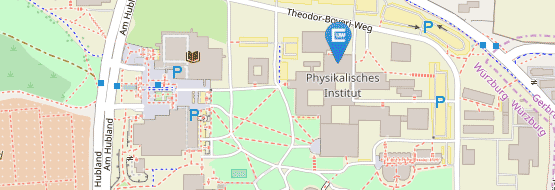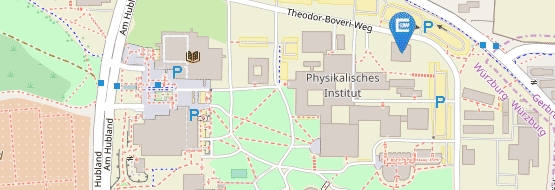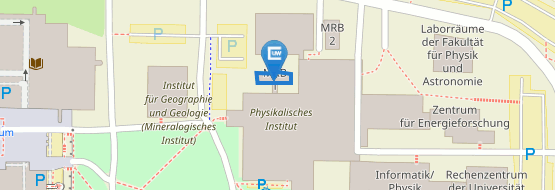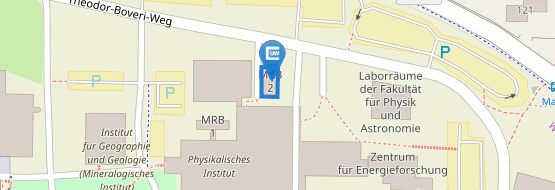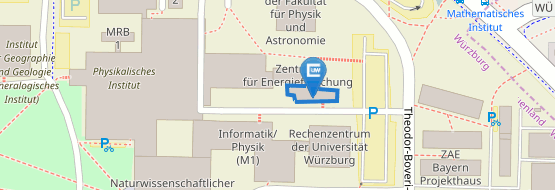Publications
Nano-Optics and Biophotonics
Latest publications
Individually Addressable Nanoscale OLEDs
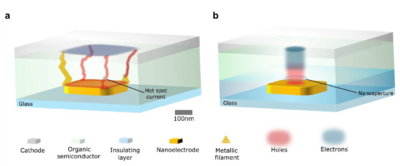
Augmented Reality (AR) and Virtual Reality (VR), require miniaturized displays with ultrahigh pixel densities. Here, we demonstrate an individually addressable subwavelength OLED pixel based on a nanoscale electrode capable of supporting plasmonic modes. Our approach is based on the notion that when scaling down pixel size, the 2D planar geometry of conventional organic light-emitting diodes (OLEDs) evolves into a significantly more complex 3D geometry governed by sharp nanoelectrode contours. These cause (i) spatially imbalanced charge carrier transport and recombination, resulting in a low quantum efficiency, and (ii) filament growth, leading to rapid device failure. Here, we circumvent such effects by selectively covering sharp electrode contours with an insulating layer, while utilizing a nano-aperture in flat areas of the electrode. We thereby ensure controlled charge carrier injection and recombination at the nanoscale and suppress filament growth. As a proof of principle, we first demonstrate stable and efficient hole injection from Au nanoelectrodes in hole-only devices with above 90 % pixel yield and longtime operation stability and then a complete vertical OLED pixel with an individually addressable nanoelectrode (300 x 300 nm2), highlighting the potential to further leverage plasmonic nanoantenna effects to enhance the performance and functionality of nano-OLEDs.
Cheng Zhang, Björn Ewald, Leo Siebigs, Luca Steinbrecher, Maximilian Rödel, Monika Emmerling, Jens Pflaum, Bert Hecht, arxiv (2024)
https://arxiv.org/abs/2409.20080
Room-temperature quantum nanoplasmonic coherent perfect absorption

Light-matter superposition states obtained via strong coupling play a decisive role in quantum information processing, but the deleterious effects of material dissipation and environment-induced decoherence inevitably destroy coherent light-matter polaritons over time. Here, we propose the use of coherent perfect absorption under near-field driving to prepare and protect the polaritonic states of a single quantum emitter interacting with a plasmonic nanocavity at room temperature. Our scheme of quantum nanoplasmonic coherent perfect absorption leverages an inherent frequency specificity to selectively initialize the coupled system in a chosen plasmon-emitter dressed state, while the coherent, unidirectional and non-perturbing near-field energy transfer from a proximal plasmonic waveguide can in principle render the dressed state robust against dynamic dissipation under ambient conditions. Our study establishes a previously unexplored paradigm for quantum state preparation and coherence preservation in plasmonic cavity quantum electrodynamics, offering compelling prospects for elevating quantum nanophotonic technologies to ambient temperatures.
Y. Lai, D.D.A. Clarke, P. Grimm, A. Devi, D. Wigger, T. Helbig, T. Hofmann, R. Thomale, J.-S. Huang, B. Hecht & O. Hess, Nature Communications 15, 6324 (2024) https://www.nature.com/articles/s41467-024-50574-9
Modulation of surface response in a single plasmonic nanoresonator
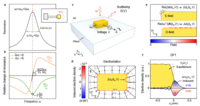
Scattering of light by plasmonic nanoparticles is classically described using bulk material properties with infinitesimally thin boundaries. However, because of the quantum nature of electrons, real interfaces have finite thickness, leading to nonclassical surface effects that influence light scattering in small particles. Electrical gating offers a promising route to control and study these effects, as static screening charges reside at the boundary. We investigate the modulation of the surface response upon direct electrical charging of single plasmonic nanoresonators. By analyzing measured changes in light scattering within the framework of surface response functions, we find the resonance shift well accounted for by modulation of the classical in-plane surface current. Unexpectedly, we also observed a change in the resonance width, indicating reduced losses for negatively charged resonators. This effect is attributed to a nonclassical out-of-plane surface response, extending beyond pure spill-out effects. Our experiments pave the way for electrically driven plasmonic modulators and metasurfaces, leveraging control over nonclassical surface effects.
Zurak, Luka; Wolff, Christian; Meier, Jessica; Kullock, René; Mortensen, N. Asger; Hecht, Bert; Feichtner, Thorsten
Science Advances: https://www.science.org/doi/10.1126/sciadv.adn5227
Chiral and directional optical emission from a dipole source coupled to a helical plasmonic antenna
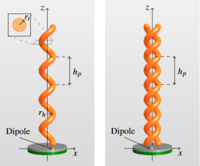
Plasmonic antennas with helical geometry are capable transducers between linearly polarized dipole emission and purely circular polarized far-fields. Besides large Purcell enhancements they possess a wide tunability due to the geometry dependence of their resonant modes. Here, the coupling of a dipole emitter embedded in a thin film to plasmonic single and double helices is numerically studied. Using a higher-order finite element method (FEM) the wavelength dependent Purcell enhancement of a dipole with different positions and orientations is calculated and the far-fields with respect to their chirality and radiation patterns are analyzed. Both single and double helices demonstrate highly directional and circularly polarized far-fields for resonant excitation but with significantly improved directional radiation for the case of double helices.
Kuen, Lilli; Löffler, Lorenz; Tsarapkin, Aleksei; Zschiedrich, Lin; Feichtner, Thorsten; Burger, Sven; Höflich, Katja
https://browse.arxiv.org/abs/2402.00664
Site-selective functionalization of in-plane nanoelectrode-antennas
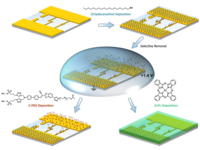
Stacked organic optoelectronic devices make use of electrode materials with different work functions, leading to efficient large area light emission. In contrast, lateral electrode arrangements offer the possibility to be shaped as resonant optical antennas, radiating light from subwavelength volumes. However, tailoring electronic interface properties of laterally arranged electrodes with nanoscale gaps - to e.g. optimize charge-carrier injection - is rather challenging, yet crucial for further development of highly efficient nanolight sources. Here, we demonstrate site-selective functionalization of laterally arranged micro- and nanoelectrodes by means of different self-assembled monolayers. Upon applying an electric potential across nanoscale gaps, surface-bound molecules are removed selectively from specific electrodes by oxidative desorption. Kelvin-probe force microscopy as well as photoluminescence measurements are employed to verify the success of our approach. Moreover, we obtain asymmetric current–voltage characteristics for metal–organic devices in which just one of the electrodes is coated with 1-octadecanethiol; further demonstrating the potential to tune interface properties of nanoscale objects. Our technique paves the way for laterally arranged optoelectronic devices based on selectively engineered nanoscale interfaces and in principle enables molecular assembly with defined orientation in metallic nano-gaps.
Ochs, Maximilian; Jucker, Laurent; Rödel, Maximilian; Emmerling, Monika; Kullock, René; Pflaum, Jens; Mayor, Marcel; Hecht, Bert
https://doi.org/10.1039/D2NR06343C
Evolutionary Optimized, Monocrystalline Gold Double Wire Gratings as a SERS Sensing Platform
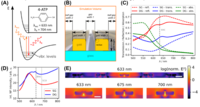
Achieving reliable and quantifiable performance in large-area surface-enhanced Raman spectroscopy (SERS) substrates has long been a formidable challenge. It requires substantial signal enhancement while maintaining a reproducible and uniform response. Conventional SERS substrates are typically made of inhomogeneous materials with random resonator geometries and distributions. As a result, they exhibit several or broadened plasmonic resonances, undesired absorptive losses, and inhomogeneous field enhancement. These limitations diminish the signal strength and hamper reproducibility, making it difficult to conduct comparative studies with high sensitivity. In this study, we propose an approach that utilizes monocrystalline gold flakes to fabricate well-defined gratings composed of plasmonic double-wire resonators, which are fabricated through focused ion-beam lithography. The geometry of the double wire grating substrate (DWGS) was evolutionary optimized to achieve efficient enhancement for both excitation and emission processes. The use of monocrystalline material minimizes absorption losses while enhancing the shape fidelity during the nanofabrication process. The DWGS shows notable reproducibility (RSD=6.6%), repeatability (RSD=5.6%), and large-area homogeneity over areas >104μm2. Moreover, it provides a SERS enhancement factor of ≈106 for 4-Aminothiophenol (4-ATP) analyte and detection capability for sub-monolayer coverage. The DWGS demonstrates reusability, as well as long-term stability on the shelf. Experimental validation with various analytes, in different states of matter, including biological macromolecules, confirms the sensitive and reproducible nature of DWGSs, thereby establishing them as a promising SERS substrate design for future sensing applications.
Sweedan, Amro; Pavan, Mariela J.; Schatz, Enno; Maaß, Henriette; Tsega, Ashageru; Tzin, Vered; Höflich, Katja; Mörk, Paul; Feichtner, Thorsten; Y. Bashouti, Muhammad
arXiv:2308.01395
Anticrossing of a plasmonic nanoresonator mode and a single quantum dot at room temperature
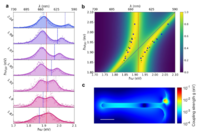
Room-temperature strong coupling of a single quantum emitter and a single resonant plasmonic mode is a key resource for quantum information processing and quantum sensing at ambient conditions. To beat dephasing, ultrafast energy transfer is achieved by coupling single emitters to a plasmonic nanoresonator with an extremely small mode volume and optimal spectral overlap. Typically, normal mode splittings in luminescence spectra of single-emitter strongly-coupled systems are provided as evidence for strong coupling and to obtain rough estimates of the light-matter coupling strength g. However, a complete anticrossing of a single emitter and a cavity mode as well as the characterization of the uncoupled constituents is usually hard to achieve. Here, we exploit the light-induced oxygen-dependent blue-shift of individual CdSe/ZnS semiconductor quantum dots to tune their transition energy across the resonance of a scanning plasmonic slit resonator after characterizing both single emitter and nano resonator in their uncoupled states. Our results provide clear proof of single-emitter strong light-matter coupling at ambient condition as well as a value for the Rabi splitting at zero detuning 100 meV, consistent with modeling, thereby opening the path towards plexitonic devices that exploit single-photon nonlinearities at ambient conditions.
Friedrich, Daniel; Qin, Jin; Schurr, Benedikt; Tufarelli, Tommaso; Groß, Heiko; Hecht, Bert
arXiv:2210.14105
Controlling field asymmetry in nanoscale gaps for second harmonic generation
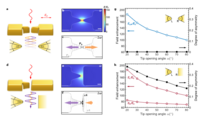
Plasmonic dimer antennas create strong field enhancement by squeezing light into a nanoscale gap. These optical hotspots are highly attractive for boosting nonlinear processes, such as harmonic generation, photoelectron emission, and ultrafast electron transport. Alongside large field enhancement, such phenomena often require control over the field asymmetry in the hotspot, which is challenging considering the nanometer length scales. Here, by means of strongly enhanced second harmonic generation, we demonstrate unprecedented control over the field distribution in a hotspot by systematically introducing geometrical asymmetry to the antenna gap. We use focused helium ion beam milling of mono-crystalline gold to realize asymmetric-gap dimer antennas in which an ultra-sharp tip with 3 nm apex radius faces a flat counterpart, conserving the bonding antenna mode and the concomitant field enhancement at the fundamental frequency. By decreasing the tip opening angle, we are able to systematically increase both field enhancement and asymmetry, thus enhancing second harmonic radiation to the far-field, which is nearly completely suppressed for equivalent symmetric dimer antennas. Combining these findings with second harmonic radiation patterns as well as quantitative nonlinear simulations, we further obtain remarkably detailed insights into the mechanism of second harmonic generation at the nanoscale. Our results open new opportunities for the realization of novel nonlinear nanoscale systems, where the control over local field asymmetry in combination with large field enhancement is essential to create nonreciprocal functionalities.
Meier, Jessica; Zurak, Luka; Locatelli, Andrea; Feichtner, Thorsten; Kullock, René; Hecht, Bert
Adv. Optical Mater.2023,11, 2300731, https://doi.org/10.1002/adom.202300731
Detection of a plasmon-polariton quantum wave packet
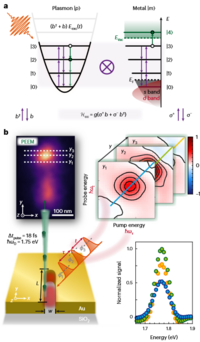
Plasmon polaritons (plasmons, for simplicity) have become paramount for tailored nanoscale light–matter interaction, and extensive research has been conducted to monitor and manipulate their spatial3 and spatio-temporal dynamics. These dynamics result from the superposition of various plasmon modes, which are classical wave packets. Beyond this classical picture, plasmon modes are treated as quasiparticles and they are considered essential for the realization of future nanoscale quantum functionality. Implementing and demonstrating such functionality requires access to the quasiparticle’s quantum state to monitor and manipulate its corresponding quantum wave packet dynamics in Hilbert space. Here we report the local detection of nanoscale plasmon quantum wave packets using plasmon-assisted electron emission as a signal in coherent two-dimensional nanoscopy. The observation of a quantum coherence oscillating at the third harmonic of the plasmon frequency is traced back to the superposition of energetically non-adjacent plasmon occupation number states and is therefore a direct fingerprint of the quantum wave packet. Beyond demonstrating the existence of a plasmon quantum wave packet via the coherence between certain occupation number states and providing an improved model for plasmon-assisted electron emission processes, the results may enable time-dependent probing and manipulation of coupled quantum states and dynamics on the nanoscale.
Development of Rotaxanes as E-Field-Sensitive Superstructures in Plasmonic Nano-Antennas
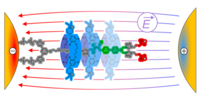
We present the concept of electrostatic field-driven supra-molecular translation within electrically connected plasmonic nano-antennas. The antenna serves as an anchoring point for the mechanically interlocked molecules, as an electrode for the electrostatic field, and as an amplifier of the antenna-enhanced fluorescence. The synthesis of a push–pull donor–π–acceptor chromophore with optical properties aligned to the antenna resonance is described and its immobilization on the surface is demonstrated. Photoluminescence experiments of the chromophore on a gold nano-antenna are shown, highlighting the molecule–antenna coupling and resulting emission intensity increase. The successful synthesis of an electrostatic field-sensitive [2]rotaxane in water is described and the tightrope walk between functionality and water solubility is illustrated by unsuccessful designs. In solution, an enhanced fluorescence quantum yield is observed for the chromophore comprising the mechanically interlocked [2]rotaxane in water and DMSO compared to the reference rod, ideal for future experiments in plasmonic nano-antennas.
L. Jucker, M. Ochs, R. Kullock, Y. Aeschi, B. Hecht, M. Mayor
Organic Materials, 4, 127-136 (2022)
Coherent Control of the Nonlinear Emission of Single Plasmonic Nanoantennas by Dual-Beam Pumping
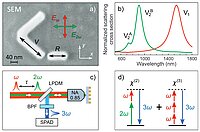
The control of nonlinear optical signals in nanostructured systems is pivotal to develop functional devices suitable for integration in optical platforms. A possible control mechanism is exploiting coherent interactions between different nonlinear optical processes. Here, this concept is implemented by taking advantage of the strong field enhancement and high optical non-linearity provided by plasmonic nanostructures. Two beams, one at the angular frequency ω, corresponding to the telecom wavelength λ= 1551 nm, and the other at 2ω, are combined to generate a sum-frequency signal at 3ω from single asymmetric gold nanoantennas. This nonlinear signal interferes with the third-harmonic radiation generated by the beam at ω, resulting in a modulation up to 50% of the total signal at 3ω depending on the relative phase between the beams. Such a large intensity modulation of the nonlinear signal is accompanied by a rotation of its polarization axis, due to the lack of central symmetry of the nanostructure. The demonstration that the nonlinear emission can be coherently controlled through the phase difference of the two-color illumination represents a promising route toward all-optical logic operations at the nanoscale through nonlinear optical signal manipulation.
A. D. Francescantonio, A. Locatelli, X. Wu, A. Zilli, T. Feichtner, P. Biagioni, L. Duò, D. Rocco, C. D. Angelis, M. Celebrano, B. Hecht and M. Finazzi
Adv. Optical Mater, 2200757 (2022)
Tunable nano-plasmonic photodetectors
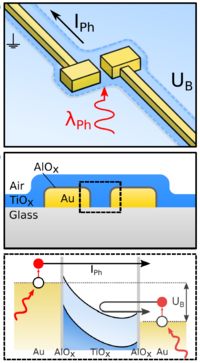
Visible and infrared photons can be detected with a broadband response via the internal photoeffect. By using plasmonic nanostructures, i.e. nanoantennas, wavelength selectivity can be introduced to such detectors through geometry-dependent resonances. Also, additional functionality, like electronic responsivity switching and polarization detection have been realized. However, previous devices consisted of large arrays of nanostructures to achieve detectable photocurrents. Here we show that this concept can be scaled down to a single antenna level, resulting in detector dimensions well below the resonance wavelength of the device. Our design consists of a single electrically-connected plasmonic nanoantenna covered with a wide-bandgap semiconductor allowing broadband photodetection in the VIS/NIR via injection of hot carriers. We demonstrate electrical switching of the color sensitivity as well as polarization detection. Our results hold promise for the realization of ultra small, highly integratable photodetectors with advanced functionality.
P. Pertsch, R. Kullock, V. Gabriel, L. Zurak, M. Emmerling, B. Hecht
Nano Lett. 2022, 22, 17, 6982–6987
Light-driven microdrones
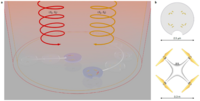
When photons interact with matter, forces and torques occur due to the transfer of linear and angular momentum, respectively. The resulting accelerations are small for macroscopic objects but become substantial for microscopic objects with small masses and moments of inertia, rendering photon recoil very attractive to propel micro- and nano-objects. However, until now, using light to control object motion in two or three dimensions in all three or six degrees of freedom has remained an unsolved challenge. Here we demonstrate light-driven microdrones (size roughly 2 μm and mass roughly 2 pg) in an aqueous environment that can be manoeuvred in two dimensions in all three independent degrees of freedom (two translational and one rotational) using two overlapping unfocused light fields of 830 and 980 nm wavelength. To actuate the microdrones independent of their orientation, we use up to four individually addressable chiral plasmonic nanoantennas acting as nanomotors that resonantly scatter the circular polarization components of the driving light into well-defined directions. The microdrones are manoeuvred by only adjusting the optical power for each motor (the power of each circular polarization component of each wavelength). The actuation concept is therefore similar to that of macroscopic multirotor drones. As a result, we demonstrate manual steering of the microdrones along complex paths. Since all degrees of freedom can be addressed independently and directly, feedback control loops may be used to counteract Brownian motion. We posit that the microdrones can find applications in transport and release of cargos, nanomanipulation, and local probing and sensing of nano and mesoscale objects.
X. Wu, R. Ehehalt, G. Razinskas, T. Feichtner, J. Qin, B. Hecht
Nature Nanotech., s41565-022-01099 (2022)
https://rdcu.be/cLP6O
further coverage:
Nature Research Highlight
Nature Community blog post
Color-Switchable Subwavelength Organic Light-Emitting Antennas
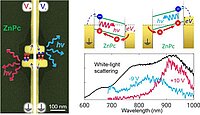
Future photonic devices require efficient, multifunctional, electrically driven light sources with directional emission properties and subwavelength dimensions. Electrically driven plasmonic nanoantennas have been demonstrated as enabling technology. Here, we present the concept of a nanoscale organic light-emitting antenna (OLEA) as a color- and directionality-switchable point source. The device consists of laterally arranged electrically contacted gold nanoantennas with their gap filled by the organic semiconductor zinc phthalocyanine (ZnPc). Since ZnPc shows preferred hole conduction in combination with gold, the recombination zone relocates depending on the polarity of the applied voltage and couples selectively to either of the two antennas. Thereby, the emission characteristics of the device also depend on polarity. Contrary to large-area OLEDs where recombination at metal contacts significantly contributes to losses, our ultracompact OLEA structures facilitate efficient radiation into the far-field rendering transparent electrodes obsolete. We envision OLEA structures to serve as wavelength-scale pixels with tunable color and directionality for advanced display applications.
P. Grimm, S. Zeißner, M. Rödel, S. Wiegand, S. Hammer, M. Emmerling, E. Schatz, R. Kullock, J Pflaum, B. Hecht
Nano Lett., 1c03994 (2022)
Single quantum emitter Dicke enhancement
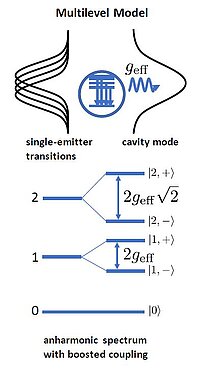
Coupling N identical emitters to the same field mode is a well-established method to enhance light-matter interaction. However, the resulting √N boost of the coupling strength comes at the cost of a “linearized” (effectively semiclassical) dynamics. Here, we instead demonstrate a new approach for enhancing the coupling constant of a single quantum emitter, while retaining the nonlinear character of the light-matter interaction. We consider a single quantum emitter with N nearly degenerate transitions that are collectively coupled to the same field mode. We show that in such conditions an effective Jaynes-Cummings model emerges with a boosted coupling constant of order √N. The validity and consequences of our general conclusions are analytically demonstrated for the instructive case N=2. We further observe that our system can closely match the spectral line shapes and photon autocorrelation functions typical of Jaynes-Cummings physics, proving that quantum optical nonlinearities are retained. Our findings match up very well with recent broadband plasmonic nanoresonator strong-coupling experiments and will, therefore, facilitate the control and detection of single-photon nonlinearities at ambient conditions.
T. Tufarelli, D. Friedrich, H. Groß, J. Hamm, O. Hess, B. Hecht
Phys. Rev. Research 3, 033103 (2021)
arXiv:2010.12585v2





